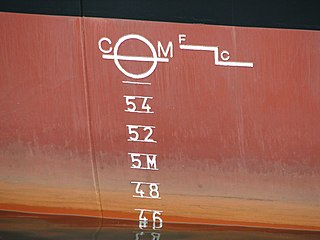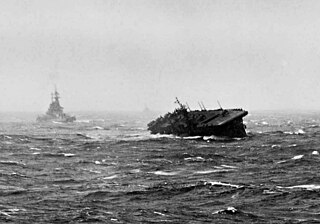
Naval architecture, or naval engineering, is an engineering discipline incorporating elements of mechanical, electrical, electronic, software and safety engineering as applied to the engineering design process, shipbuilding, maintenance, and operation of marine vessels and structures. Naval architecture involves basic and applied research, design, development, design evaluation (classification) and calculations during all stages of the life of a marine vehicle. Preliminary design of the vessel, its detailed design, construction, trials, operation and maintenance, launching and dry-docking are the main activities involved. Ship design calculations are also required for ships being modified. Naval architecture also involves formulation of safety regulations and damage-control rules and the approval and certification of ship designs to meet statutory and non-statutory requirements.

The metacentric height (GM) is a measurement of the initial static stability of a floating body. It is calculated as the distance between the centre of gravity of a ship and its metacentre. A larger metacentric height implies greater initial stability against overturning. The metacentric height also influences the natural period of rolling of a hull, with very large metacentric heights being associated with shorter periods of roll which are uncomfortable for passengers. Hence, a sufficiently, but not excessively, high metacentric height is considered ideal for passenger ships.

A ship model basin is a basin or tank used to carry out hydrodynamic tests with ship models, for the purpose of designing a new ship, or refining the design of a ship to improve the ship's performance at sea. It can also refer to the organization that owns and operates such a facility.

Capsizing or keeling over occurs when a boat or ship is rolled on its side or further by wave action, instability or wind force beyond the angle of positive static stability or it is upside down in the water. The act of recovering a vessel from a capsize is called righting. Capsize may result from broaching, knockdown, loss of stability due to cargo shifting or flooding, or in high speed boats, from turning too fast.

The waterline is the line where the hull of a ship meets the surface of the water. Specifically, it is also the name of a special marking, also known as an international load line, Plimsoll line and water line, that indicates the draft of the ship and the legal limit to which a ship may be loaded for specific water types and temperatures in order to safely maintain buoyancy, particularly with regard to the hazard of waves that may arise. Varying water temperatures will affect a ship's draft, because warm water is less dense than cold water, providing less buoyancy. In the same way, fresh water is less dense than salinated or seawater with a similar lessening effect upon buoyancy.

A chief mate (C/M) or chief officer, usually also synonymous with the first mate or first officer, is a licensed mariner and head of the deck department of a merchant ship. The chief mate is customarily a watchstander and is in charge of the ship's cargo and deck crew. The actual title used will vary by ship's employment, by type of ship, by nationality, and by trade: for instance, chief mate is not usually used in the Commonwealth, although chief officer and first mate are; on passenger ships, the first officer may be a separate position from that of the chief officer that is junior to the latter.
A second mate or second officer (2/O) is a licensed member of the deck department of a merchant ship holding a Second Mates Certificate of Competency, which is issued by the administration. The second mate is the third in command and a watchkeeping officer, customarily the ship's navigator. Other duties vary, but the second mate is often the medical officer and in charge of maintaining distress signaling equipment. On oil tankers, the second mate usually assists the chief mate with the cargo operations.

A third mate (3/M) or third officer is a licensed member of the deck department of a merchant ship. The third mate is a watchstander and customarily the ship's safety officer and fourth-in-command. The position is junior to a second mate. Other duties vary depending on the type of ship, its crewing, and other factors.

A motion simulator or motion platform is a mechanism that creates the feelings of being in a real motion environment. In a simulator, the movement is synchronised with a visual display of the outside world (OTW) scene. Motion platforms can provide movement in all of the six degrees of freedom (DOF) that can be experienced by an object that is free to move, such as an aircraft or spacecraft:. These are the three rotational degrees of freedom and three translational or linear degrees of freedom.
In the field of ship design and design of other floating structures, a response amplitude operator (RAO) is an engineering statistic, or set of such statistics, that are used to determine the likely behavior of a ship when operating at sea. Known by the acronym of RAO, response amplitude operators are usually obtained from models of proposed ship designs tested in a model basin, or from running specialized CFD computer programs, often both. RAOs are usually calculated for all ship motions and for all wave headings.

Ship motions are defined by the six degrees of freedom that a ship, boat or any other craft can experience.
A following sea refers to a wave direction that is similar to the heading of a waterborne vessel under way. The word "sea" in this context refers to open water wind waves.

A sea trial is the testing phase of a watercraft. It is also referred to as a "shakedown cruise" by many naval personnel. It is usually the last phase of construction and takes place on open water, and it can last from a few hours to many days.

Ship stability is an area of naval architecture and ship design that deals with how a ship behaves at sea, both in still water and in waves, whether intact or damaged. Stability calculations focus on centers of gravity, centers of buoyancy, the metacenters of vessels, and on how these interact.
The sopite syndrome is a neurological disorder that relates symptoms of fatigue, drowsiness, and mood changes to prolonged periods of motion. The sopite syndrome has been attributed to motion-induced drowsiness such as that experienced by a baby when rocked. Researchers Ashton Graybiel and James Knepton at the Naval Aerospace Medical Research Laboratory first used the term "the sopite syndrome", in 1976, to refer to the sometimes sole manifestation of motion sickness, though other researchers have referred to it as "Sopite syndrome."
Noise and vibration on maritime vessels are not the same but they have the same origin and come in many forms. The methods to handle the related problems are similar, to a certain level, where most shipboard noise problems are reduced by controlling vibration.
Seaworthiness is a concept that runs through maritime law in at least four contractual relationships. In a marine insurance voyage policy, the assured warrants that the vessel is seaworthy. A carrier of goods by sea owes a duty to a shipper of cargo that the vessel is seaworthy at the start of the voyage. A shipowner warrants to a charterer that the vessel under charter is seaworthy; and similarly, a shipbuilder warrants that the vessel under construction will be seaworthy.

Dismasting, also spelled demasting, occurs to a sailing ship when one or more of the masts responsible for hoisting the sails that propel the vessel breaks. Dismasting usually occurs as the result of high winds during a storm acting upon masts, sails, rigging, and spars. Over compression of the mast owing to tightening the rigger too much and g-forces as a consequence of wave action and the boat swinging back and forth can also be result in a dismasting. Dismasting does not necessarily impair the vessel's ability to stay afloat, but rather its ability to move under sail power. Frequently, the hull of the vessel remains intact, upright and seaworthy.

The Terrible class was a group of four ironclad barbette ships built for the French Navy in the late 1870s and early 1880s. The class consisted of Terrible, Indomptable, Caïman, and Requin, and is sometimes referred to as the Indomptable class. They were built as part of a fleet plan started in 1872 after the Franco-Prussian War and were designed in response to the German Sachsen class of barbette ships. The Terribles were scaled down versions of the Amiral Baudin class, with one less main gun, though they were of significantly larger caliber. Because the ships were intended for operations against the German fleet in the shallow Baltic Sea, they had a low draft and freeboard, which greatly hampered their seakeeping and thus reduced their ability to be usefully employed after entering service. Armament consisted of a pair of 420 mm (16.5 in) guns in individual barbettes, which were the largest guns ever mounted on a French capital ship.
This glossary of nautical terms is an alphabetical listing of terms and expressions connected with ships, shipping, seamanship and navigation on water. Some remain current, while many date from the 17th to 19th centuries. The word nautical derives from the Latin nauticus, from Greek nautikos, from nautēs: "sailor", from naus: "ship".















